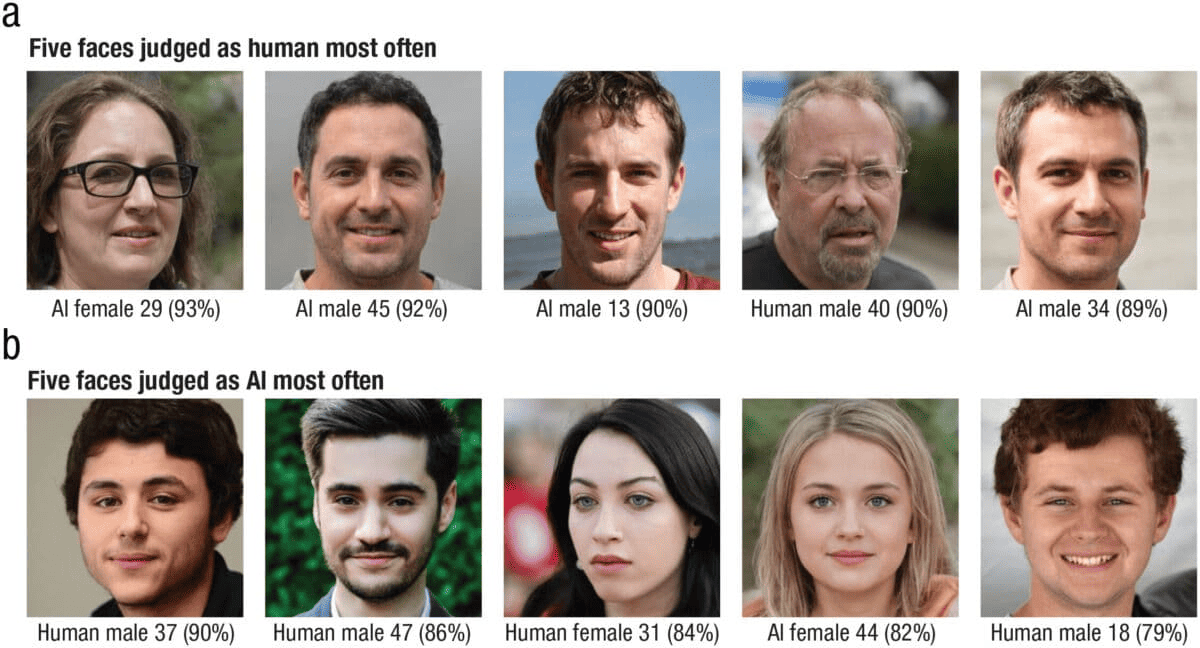
Artificial Intelligence went from creating silly images to producing indistinguishably good portraits in just a couple of years. Now, researchers show that in some instances, AI-generated images are even more convincing than the real deal.
In a world where technology increasingly blurs the lines between the real and the artificial, this is concerning in more ways than one.
Face experiments
In the new study, researchers conducted two experiments. The first experiment had 124 participants view 100-AI generated faces and 100 photos of real people. The participants (all white) were asked to decide whether each face was AI-generated or real, and how confident they were on a 100-point scale.
All portraits here were of Caucasian-looking humans. Out of the human images, participants only thought that 51% were real. But out of the AI images, 66% were classed as real.
“Remarkably, White AI faces can convincingly pass as more real than human faces — and people do not realize they are being fooled,” the researchers note in the study. “Problematically, the people who were most likely to be fooled by AI faces were the least likely to detect that they were being fooled,” they add, as these participants showed the highest confidence in their answers.
In the second experiment, 610 participants were shown another mix of AI and human faces. The study delved deeper into this bias, asking participants to rate which features distinguish AI from non-AI. The experiment pointed out that non-white AI-generated faces did not receive the same level of mistaken identity as their white counterparts, being identified correctly about half of the time. This discrepancy suggests that AI’s proficiency in generating realistic images is uneven across different racial groups.
“Here, we show that White (but not non-White) AI faces are, remarkably, judged as human more often than pictures of actual humans. We pinpoint the perceptual qualities of faces that contribute to this hyperrealism phenomenon, including facial proportions, familiarity, and memorability,” the researchers note.
Bias, bias
We’ve been hearing a lot recently about the immense potential of generative AI, and it’s true. However, the advancement of AI technology also brings with it a host of challenges. While AI’s ability to create hyper-realistic images opens new avenues in fields like entertainment and virtual reality, it also necessitates a rigorous examination of the ethical implications of its use.
This research not only highlights the advanced state of AI in creating lifelike images but also underscores a significant racial bias in the technology. The AI systems, predominantly trained on datasets featuring white faces, have become adept at replicating them, leaving other racial groups underrepresented and potentially misrepresented.
“Our study highlights two separate, and critical, biases. First, generative adversarial networks (GANs) are biased toward the statistical regularities of their most common inputs, which we argue produces AI hyperrealism.”
“Second, we found evidence of White racial bias in algorithmic training that produces racial differentials in the presence of AI hyperrealism, with significant implications for the use of AI faces online and in science.”
It’s not the first time that racial bias in AI has been highlighted. AI tools were often demonstrated to default to dangerous tropes and biases, and while image generators like Stable Diffusion and DALL-E are making efforts to reduce biases, these biases are far from gone.
So, there are two main takeaways from this work. The first is that biases are still prevalent in current AI systems, and we need better ways to deal with that. The second is that our ability to detect what’s AI made and what’s real is not nearly good enough.
“Given that humans are unable to detect current AI faces, society needs tools that can accurately identify AI imposters,” the researchers conclude.
The study “AI Hyperrealism: Why AI Faces Are Perceived as More Real Than Human Ones” was published in Psychological Science.






